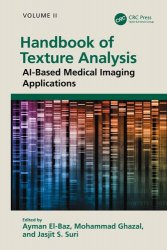Handbook of Texture Analysis: Generalized Texture for AI-Based Industrial Applications
- Добавил: literator
- Дата: 14-06-2024, 03:47
- Комментариев: 0
 Название: Handbook of Texture Analysis: Generalized Texture for AI-Based Industrial Applications, Volume II
Название: Handbook of Texture Analysis: Generalized Texture for AI-Based Industrial Applications, Volume IIАвтор: Ayman El-Baz, Mohammed Ghazal, Jasjit S. Suri
Издательство: CRC Press
Год: 2024
Страниц: 271
Язык: английский
Формат: pdf (true)
Размер: 10.1 MB
The major goals of texture research in computer vision are to understand, model, and process texture, and ultimately, to simulate the human visual learning process using computer technologies. In the last decade, Artificial Intelligence (AI) has been revolutionized by Machine Learning and Big Data approaches, outperforming human prediction on a wide range of problems. In particular, Deep Learning convolutional neural networks (CNNs) are particularly well suited to texture analysis.
This book examines four major application domains related to texture analysis and their relationship to AI-based industrial applications: texture classification, texture segmentation, shape from texture, and texture synthesis.
Computer vision concerns itself with computationally achieving a high-level perception and understanding (approximating the performance of human cognition) of digital images and videos. It attempts the automation of tasks naturally accomplished by the human visual apparatus. Computer vision encompasses scientific methods for the acquisition, processing, analysis, and interpretation of digital images and extraction of multidimensional data from the physical world with a view to produce numerical or symbolic information. For any computer vision applications, the input data is an image or a video, and the objective is to understand the image and its contents. If the goal is to create an application of human vision—like object recognition, defect detection, etc.—then it may be called computer vision.
Texture analysis is a technique for visualizing regions in an image by analyzing the texture information of those regions. Tactile texture refers to the physical feel of a surface, and visual texture refers to viewing the shape or the contents of an image. In the human vision system, textures diagnosis is relatively feasible, but machine vision and image processing have their own difficulties. Texture feature is a complicated visual design made up of patterns/sub-patterns with extensive characteristics, such as color, intensity, shape, size, slope, etc. It is defined as the changes in pixel intensities and orientation in a spatial domain. Texture information is a useful low-level characteristic that may be utilized to find objects in an image’s region of interest. Various textures in an image can be recognized and characterized by considering the distinctive features that define each class of a texture. Since there are several advanced classifiers that exist, the primary difficulty is to generate important features to extract from an image. Texture analysis is broadly used in the domain of image processing, object recognition, remote sensing applications, surface defect detection, biomedical analysis, document processing, pattern recognition, and so on.
This volume:
• Discusses texture-based segmentation for extracting image shape features, modeling and segmentation of noisy and textured images, spatially constrained color-texture model for image segmentation, and texture segmentation using Gabor filters.
• Examines textural features for image classification, a statistical approach for classification, texture classification from random features, and applications of texture classifications.
• Describes shape from texture, including general principles, 3D shapes, and equations for recovering shape from texture
• Surveys texture modeling, including extraction based on Hough transformation and cycle detection, image quilting, gray level run lengths, and use of Markov random fields.
Aimed at researchers, academics, and advanced students in biomedical engineering, image analysis, cognitive science, and Computer Science and engineering, this is an essential reference for those looking to advance their understanding in this applied and emergent field.
Скачать Handbook of Texture Analysis: Generalized Texture for AI-Based Industrial Applications, Volume II
Внимание
Уважаемый посетитель, Вы зашли на сайт как незарегистрированный пользователь.
Мы рекомендуем Вам зарегистрироваться либо войти на сайт под своим именем.
Уважаемый посетитель, Вы зашли на сайт как незарегистрированный пользователь.
Мы рекомендуем Вам зарегистрироваться либо войти на сайт под своим именем.
Информация
Посетители, находящиеся в группе Гости, не могут оставлять комментарии к данной публикации.
Посетители, находящиеся в группе Гости, не могут оставлять комментарии к данной публикации.
